
Griffiths, Bulletin of the Torrey Botanical Club 43(2): 89, 1916
Original Citation
What is Opuntia semispinosa?
Opuntia semispinosa is a coastal pricklypear cactus from southern California and Mexico that has been variously lumped into O. occidentalis, O. littoralis, or even other Opuntias of Southern California. We accept it as a stand-alone species.
Details
Plants may reach 1 or 1.4 m tall and 1 or 2 m wide. Originally, the plants grew in great thickets, but land use eroded this habit. This opuntia now often grows singly or as a few individuals. This pricklypear can present as an untidy collection of branches and irregular cladodes because the branches are angular. Some plants are compact, whereas others spread. Segments of this Opuntia may be oval or obovate and or even pointed at both ends (almost rhomboid). Spines are white, but larger centrals may darken to brown at the base. Larger spines are often angular and twisted. Interestingly, areoles can sometimes be wider than long, 5 mm wide and 6-8 mm wide.
Flowers are yellow but may have a tinge of orange. Filaments are yellowish or pale green, and the style is red and large, up to 8 to 10 mm in diameter. The stigma is pale green. The outer sepals are often recurved in bud. The fruit is 35 × 50 mm and obovate with a flat umbilicus. The fruits are spiny.
Ploidy is unknown.
Other Notes
O. semispinosa was initially collected at Santa Barbara, CA, San Pedro, CA, and near Tiajuana, Mexico.
At one time, there was much interest in the plant as a possible source of spineless Opuntia germplasm because some pads are spineless over part or all of the pad (hence “semi” spinosa), but this hope was not realized. O. semispinosa is not a pricklypear generally found in gardens due to its large size.

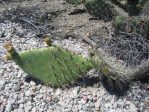
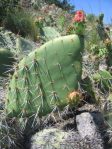
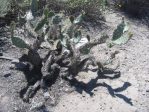
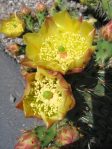
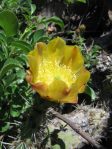
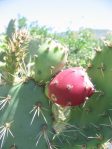
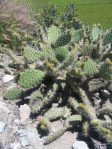
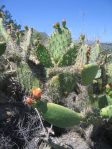
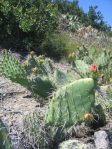

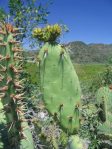
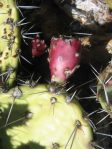

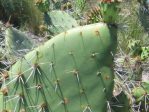
I have been hiking past this for a few years in the San Pasqual Valley, I thought it was just an odd variation of a prickly pear! It is getting rather large now, and almost no noticeable spines. It is the only one ove noticed in this eara.
I have been hiking past this for a few years in the San Pasqual Valley, I thought it was just an odd variation of a prickly pear! It is getting rather large now, and almost no noticeable spines. It is the only one I’ve noticed in this area.
Hi,
It is a bit difficult to know for sure. Opuntia ficus-indica sometimes grows wild in Southern California.
JOe